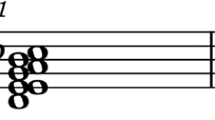
Overview
- The first dedicated study of the final works of one of the past century’s most significant composers
- Nearly 200 graphical illustrations and a detailed commentary revealing unique compositional processes
- Powerful new statistical-graphical methods for analyzing scalar stability in musical texture
Part of the book series: Computational Music Science (CMS)
Access this book
Tax calculation will be finalised at checkout
Other ways to access
About this book
In the third and final book of his iconic piano etudes György Ligeti charts a new path relative to the rest of his musical output, representing a significant arrival in a composer’s oeuvre known for its stylistic transformations. This monograph is the first dedicated study of these capstone works, investigating them through a novel lens of statistical-graphical analysis that illuminates their compositional uniqueness as well as broader questions regarding the perception of stability in musical texture.
With nearly 200 graphical illustrations and a detailed commentary, this examination reveals the unique manner in which Ligeti treads between tonality and atonality—a key idea in his late style—and the centrality of processes related to broader scale areas (or “macroharmony”) in articulating structures and narratives. The analytical techniques developed here are a powerful tool for investigating macroharmonic stability that can be applied to a wide range of repertoire beyond these works.
This book is intended for graduate-level and professional music theorists, musicologists, performers and mathematicians.
Similar content being viewed by others
Keywords
Table of contents (6 chapters)
Authors and Affiliations
About the author
Bibliographic Information
Book Title: Ligeti’s Macroharmonies
Book Subtitle: A Graphical-Statistical Analysis of Book 3 of the Piano Etudes
Authors: Nicolas Namoradze
Series Title: Computational Music Science
DOI: https://doi.org/10.1007/978-3-030-85694-6
Publisher: Springer Cham
eBook Packages: Computer Science, Computer Science (R0)
Copyright Information: The Editor(s) (if applicable) and The Author(s), under exclusive license to Springer Nature Switzerland AG 2022
Hardcover ISBN: 978-3-030-85693-9Published: 25 February 2022
Softcover ISBN: 978-3-030-85696-0Published: 26 February 2023
eBook ISBN: 978-3-030-85694-6Published: 24 February 2022
Series ISSN: 1868-0305
Series E-ISSN: 1868-0313
Edition Number: 1
Number of Pages: X, 203
Number of Illustrations: 79 b/w illustrations, 111 illustrations in colour
Topics: Mathematics in Music, Fourier Analysis, Applied Statistics, Computational Mathematics and Numerical Analysis



